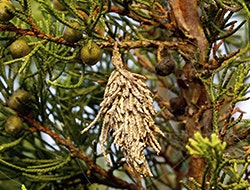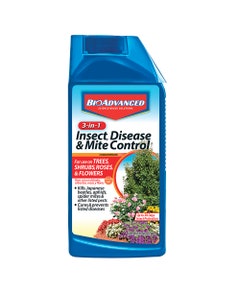

- Home
- Solution Center
- Learn
- Learn: Tree & Shrub
- Tree Insecticide: Preventing Spring Pests
Tree Insecticide: Preventing Spring Pests
Do your trees have a bug problem? Spring is a great time to get outside and inspect trees for insects. In warm areas, tree pests may remain active year-round; in colder regions, pests resume activities as spring's warmer air arrives. Learn what pests to look for and what steps you can take to deal with them.

Scale Insects
These insects form hard, colored bumps on plant stems, leaves and fruit. Scales feed by sucking plant juices and produce sticky honeydew that grows Black Mold. Infested trees can yield massive amounts of honeydew that coats objects beneath with a sticky film. The honeydew also attracts Ants, Flies, Wasps and Bees – in large numbers. Scale is tricky to treat and tough to beat when infestations are large. The best time to treat scale is when infestations first start or when the vulnerable, immature insect forms are present. Extensive infestation can kill a tree.
Examples: Euonymus Scale, Cottony Cushion Scale, Pine Needle Scale
Target plants include: Citrus, palms, fruit trees, shade trees
Other signs of Scale: Plants may appear water-stressed; leaves yellow and drop; bark can crack
Treating Scale: The waxy coating on these insects prevents insecticide sprays from having a substantial effect. You must identify the Scale insect you're dealing with to treat it correctly. For some Scale in early infestation stages, apply systemic insecticide. For others, smothering young insect stages with horticultural oil is the best control. When treating edible trees, be sure to use a product labeled for that use.
Best time to treat: Once you have identified your scale pest and determined which product to use, read the label to time applications properly. Contact your local Cooperative Extension System office for additional assistance.

Eastern Tent Caterpillar
This Caterpillar attacks trees from the East Coast to the Rocky Mountains and north into Canada. Caterpillars appear in early spring, from February in the Deep South, to May in North Dakota. Caterpillars spin silk nests in trunk forks or branch crotches, leaving the nest daily to feed. These tent-weavers don't typically harm mature trees, but their feeding can defoliate young trees, which can lead to death. In a suburban environment, Caterpillars create a nuisance on surfaces when they leave the host tree to spin cocoons.
Target plants include: Wild Cherry, Plum, Peach, Cherry, Hawthorn, Apple, Crabapple; also Attack Ash, Birch, Maple, Oak
Other signs of Tent Caterpillars: Defoliated trees
Treating Tent Caterpillars: Physically remove the web using a pole, and knock Caterpillars into soapy water. Webs are somewhat waterproof, so systemic insecticides may offer a better control option than traditional insecticide sprays.
Best time to treat: If removing nests by hand, do so when webs are small. Use a systemic insecticide in fall or very early spring.

Whitefly
This tiny white insect is typically present in warm weather. When infested plants are disturbed, clouds of Whiteflies rise. Flies are 1-3 mm long and hide beneath leaves, sucking plant juices and producing a sticky honeydew. When large numbers of Whiteflies are present, leaves may appear yellow or dry, or may drop from trees, and entire branches can die. Treat trees this spring to help prevent summer infestations.
Target plants include (depending on Whitefly species): Ash, Bradford Pear, Chestnut, Citrus, Ficus, Gumbo Limbo, Oak, Palm, Pomegranate, Redbud and many other broad-leaved trees and shrubs
Other signs of Whitefly: Sticky leaves coated with sap, which may grow Black Sooty Mold; honeydew attracts Ants
Treating Whitefly: A systemic insecticide affects feeding insects, without affecting natural Whitefly predators.
Best time to treat: Use a systemic insecticide in early spring to protect trees from summer attacks.

Emerald Ash Borer (EAB)
The adult Emerald Ash Borer beetle has a metallic green hue and is about ½-inch long. The larval form is what kills trees, devouring the tissue beneath Ash tree bark that moves water throughout the tree. The first visible sign of EAB is usually sections of the tree canopy dying, starting at the top and outside edges of the tree. Years of feeding cause the die back, but once those first symptoms are spotted, infected trees usually die within two years. Some Ash trees produce thick sprout clusters along the tree trunk or suckers at the base when EAB is active.
Target plants include: All species of North American Ash trees
Other signs of Emerald Ash Borer: One-third to one-half of canopy branches can die in one year; tree bark may split vertically; heavy woodpecker feeding on high branches
Treating Emerald Ash Borer: EAB feed beneath the bark, so the only way to treat them is with a systemic insecticide. Research shows that trees with more than 50% die back should be destroyed, not treated.
Best time to treat: Use a systemic insecticide in mid-to late spring or early to mid-fall.

Bagworms
These Caterpillars create small bags made from bits of twigs and leaves that measure up to 2.5 inches long. Look for the dangling bags along evergreen branches, the undersides of porch roofs and other surfaces. In spring, eggs that wintered inside bags hatch, and the caterpillars emerge to start the feeding and breeding cycle anew. Bagworms don't typically cause immense damage to plants, but the bags are unsightly, especially when numbers are large. In a heavy infestation, trees – even conifers – can be defoliated.
Target plants include: Deciduous and evergreen trees and shrubs; heaviest damage usually occurs on Arborvitae, Junipers and Eastern Red Cedar
Other signs of Bagworms: Ragged, chewed foliage on deciduous trees
Treating Bagworms: Remove bags by hand and drop into soapy water
Best time to treat: Gather bags as soon as you spot them, from fall through mid-spring, to ensure removal before eggs hatch. Learn more about bagworms and other pests typically spotted in fall.
Systemic Insecticides
For several of these pests, a systemic insecticide like 12 Month Tree & Shrub Protect & Feed can help suppress or even control tree pests – with limited effort on your part. Just one application provides up to one year of protection. Learn the basics of using systemic insecticides, including tips on how to time it right for best results.














